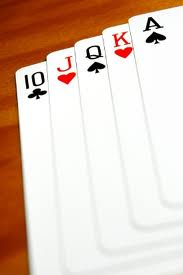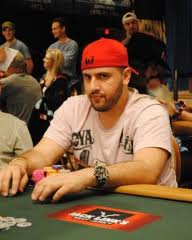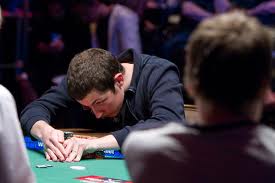Playing Three Straights in Seven Card Stud
 One nice speculative hand that seven card stud players can get on third street is a three-straight. These cards give you a solid shot at making a straight, which is one of the better hands in stud games. However, these hands aren’t always worth playing on third street, so it’s worth taking a look at what you need to consider when deciding to play three-straights. But first, beginners should read about what exactly three-flushes are.
One nice speculative hand that seven card stud players can get on third street is a three-straight. These cards give you a solid shot at making a straight, which is one of the better hands in stud games. However, these hands aren’t always worth playing on third street, so it’s worth taking a look at what you need to consider when deciding to play three-straights. But first, beginners should read about what exactly three-flushes are.
What is a Three-Straight?
Understanding a three-straight isn’t hard because this merely refers to having three cards to a straight on third street. For example, if your stud cards are 8s-9d-10h(door card), you’ve got three cards to a straight.
Factors to consider when playing a Three-Straight
Seeing as a three-straight isn’t as strong as a three-flush, you have even more factors to consider when deciding whether or not to play these stud cards. Here are the most pertinent things you need to think about with three-straights:
1. How Live your hand is
2. If you have any overcards
3. If your hand has any additional value (i.e. two-flush, pair)
4. What your door card is
5. If your three-straight is a gutshot or open-ended
6. Betting action that’s occurred before you
7. Your opponents
The idea is to look for situations where most (or all) of these aspects are in your favor; assuming there are some positive factors with your stud cards, you can call or even raise opponents. In order to better define favorable situations for playing three-straights in stud games, let’s take examine some different scenarios.
Two of your Outs are in Opponents’ Door Cards
There will be many cases where you’ve got a three-straight, and some of your outs are in opponents’ door cards. For example, let’s say that you’ve got 7s-8s-9d(upcard), while there’s a ten and a six amongst other door cards; however, no fives or jacks are out. Seeing as how two of the cards that could make your straight have been dealt, your hand is a little less “live.”
But this certainly doesn’t mean you can’t play this hand – especially with the additional two-flush value that your cards have. So if there’s a small bet made before you and no big overcards left behind you, this would be a good time to call the bet.
Now let’s change the scenario and say that one player bets and another raises on third street; here you have no business calling the raise because it’s going to be a bad decision in the long-term. Even if you were to get a 10 or 6 on fourth street, you’re still missing a couple of outs that will make your straight. So the hand isn’t totally live, and it’s normally not worth calling a sizable raise.
 You’re up against Opponents who overvalue High Pairs
You’re up against Opponents who overvalue High Pairs
Sometimes situations arise where it’s profitable to call small raises with three-straights when your opponent treats high pairs like the nuts. The reason why is because – by the time seven cards are dealt- your opponent might keep calling big bets with a high pair, thus paying your straight off.
Of course, this is by no means a green light to call raises of any size when your hand is nearly dead; however, bad opponents who might pay you off provide a little more incentive to call small raises in a stud game. Just make sure not to get carried away with this concept though.
You have a Gutshot Straight Draw
Gutshot draws (one-card gap in between a hand) aren’t nearly as profitable as open-ended straight draws in stud games. However, there are some situations in seven stud where you’ll profit over the long-term by calling with a gutshot straight draw. The main aspect you need to consider here is if your hand is totally live. For instance, with stud cards of 7s-8h-10c(door card), you really can’t have any of the 9’s showing in opponents’ upcards. The hand gains additional value if all the 6’s and jacks are still live.
Another good situation where you can play a gutshot draw in stud games is when your door card is higher than your opponents’. This gives you a chance to get high pair when your seven cards are dealt or – in a more realistic scenario – you can bluff opponents on third street, and hopefully they’ll believe you have the top pair.
You have High Cards
In some of the stud game situations we’ve discussed, it’s not a good idea to play your three-straight because of your hand being dead (too many outs missing) or the bets being too large; however, let’s assume that your three-straight is Ks-Qc-Jh. If two 10’s and a 9 were already out, this would be a bad situation.
 But with the three high cards you have, there’s great potential to at least get a high pair. So the high cards give you an even better chance to improve this hand by the time seven cards are dealt.
But with the three high cards you have, there’s great potential to at least get a high pair. So the high cards give you an even better chance to improve this hand by the time seven cards are dealt.
You have Low Cards
One very common seven card mistake that beginners make involves frequently playing three-straights comprised of lower cards. An example of one of these hands would be 5s-4d-3h; here the only value you have comes from the straight potential. This seven stud hand has no flush or high pair potential, which means if you don’t hit the straight or make an opponent fold, you have virtually no shot of winning.
That said, it’s okay to play low-card three-straights in stud games when the cost to see additional cards is really cheap and/or your outs are live. Also, if you think that you can steal the antes in late position, a low three-straight gives you something to fall back on if an opponent calls.
An Opponent is representing a Pair with Outs you need
It can’t be stressed enough how important having a live hand is when playing three-straights in a stud game. That said, your chances of having a live hand decrease even more in a stud game when an opponent not only has one of your outs in their door card, but also when they’re raising like they’ve paired this door card.
For example, if you have 8h-9d-Ts and opponent’s door card is Js, you have to be really careful if they’re raising big because they could have a pair of jacks. If this is the case, two of your outs are gone, and the hand has less value.
Speaking generally, you can see that every new situation presents a different way to play your three-straight hands. So the key is to analyze all of the factors we mentioned before so that you can make correct decisions and earn long-term profits from three-straight hands.
